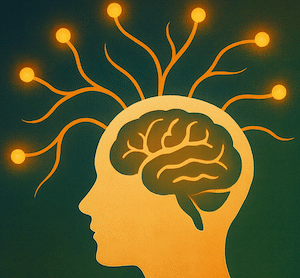
Share this post!
We take for granted that scientists and medical researchers have identified all of the systems of the human body. The cardiovascular system, with its network of arteries and veins, was described as early as 1628. Even the complex signaling pathways of the hypothalamic-pituitary-adrenal (HPA) axis were described by 1936. But there is one body system that went entirely undetected until a breakthrough discovery that happened within many of our lifetimes—less than 30 years ago. The endocannabinoid system.
The Breakthrough Discovery
It all began with marijuana. Traditional cultures had been using marijuana in religious and healing ceremonies since ancient times. By the 20th century, researchers were clamoring to uncover the compound responsible for this plant’s psychoactive effects.
Cannabidiol (CBD) was isolated from the marijuana plant in 1940, but it didn’t gain much attention because it had no psychotropic properties. Then in 1964, delta-9 tetrahydrocannabinol (THC) was discovered. It was clear that THC was responsible for marijuana’s mind-altering effects, but it took another 30 years for researchers to discover why.
The breakthrough discovery came in 1990 when researchers cloned the human receptor that binds THC: the cannabinoid 1 (CB1) receptor.
As is usually the case in science, the initial discovery of the CB1 receptor led to more questions. Why were those receptors there? Do we also produce endogenous compounds that bind to those receptors? Where are the receptors located throughout the body, and what do they do?
The answers to those questions have described a complex signaling network in the human body that has existed since the beginning of time but is only on the brink of being understood.
The Endocannabinoid System
It turns out that our cells harbor not only CB1 receptors but also CB2 and other receptors that bind active compounds in the marijuana plant. We also produce endogenous compounds that bind to those receptors, which scientists have named endocannabinoids. The other main players in this communication network are the enzymes, which synthesize and break down the endocannabinoids.
Here are the parts of the endocannabinoid system:
- The Cannabinoid Receptors. The two main cannabinoid receptors are CB1 and CB2. These receptors bind compounds in plants (phytocannabinoids) as well as signaling molecules made in the human body (endocannabinoids). CB1 receptors are found mainly in the brain (but have been detected in almost all organs and systems). CB2 receptors are concentrated on immune cells.
- The Endocannabinoids. Endocannabinoids are the signaling molecules that are made in the human body that bind to and activate cannabinoid receptors. The two main endocannabinoids that have been identified in humans are anandamide and 2-arachidonoylglycerol (2-AG). Anandamide was the first to be discovered and was given its name for the Sanskrit word “bliss.”
- The Enzymes. Endocannabinoids are synthesized on demand from fatty acids in cell membranes and then travel into the space between cells so they can bind receptors on neighboring cells (they act like neurotransmitters). The endocannabinoids remain active until metabolic enzymes degrade them. Researchers have taken an interest in targeting these enzymes as a way to prolong the activity of endocannabinoids.
Function of the Endocannabinoid System
The endocannabinoid system is a signaling network that modifies the activity of all other organs and body systems. We think about the immune system and the HPA axis and the gut-brain axis as important signaling networks in the body, but the endocannabinoid system may very well oversee them all.
CB1 receptors are concentrated in the brain but have been detected in the enteric nervous system, intestinal mucosa, adipose tissue, liver, skeletal muscle, bone, skin, eye, cardiovascular system, and reproductive system.
CB2 receptors are concentrated on immune cells but have also been detected in the peripheral nervous system and the gastrointestinal tract.
The endocannabinoid system is thought to modulate cellular function throughout the body to promote homeostasis and well-being. It plays a role in stress, sleep, mood, appetite, immunity, inflammation, and even gut function. The details of its mechanisms of action are only beginning to be understood.

Marijuana, Hemp, and the Endocannabinoid System
Marijuana was the impetus behind the discovery of the endocannabinoid system, but it isn’t the only plant that interacts with this signaling network. Marijuana is the same genus and species as hemp—both Cannabis sativa. Both marijuana and hemp interact with the endocannabinoid system but in different ways.
Marijuana has been cultivated for higher levels of THC. This is the phytocannabinoid that interacts with CB1 receptors in the brain and produces psychotropic effects. THC has been isolated for use in an FDA-approved pharmaceutical drug called Sativex.
Hemp is different than marijuana because it must contain less than 0.3% THC. As long as it meets this definition, hemp is not a controlled substance. Instead of THC, hemp contains higher levels of CBD, which exerts no psychotropic effects. Isolated CBD is used in two FDA-approved medications: Sativex and Epidiolex.
Although marijuana is known best for its THC content, and hemp is known best for its CBD content, both of these plants contain more than a hundred different phytocannabinoids. It has been suggested that the combination of plant compounds works in synergy to support the endocannabinoid system. Marijuana is a controlled substance, but whole-hemp extracts are available to consumers as herbal supplements.
Nutrition and the Endocannabinoid System
The cannabis plant is not the only plant that interacts with the endocannabinoid system. Countless other plants contain phytocannabinoids or compounds that interact in different ways with endocannabinoid metabolism and receptors—including common vegetables and spices.
Vegetables in the Brassica family, such as broccoli, cauliflower, and kale, contain a compound called diindolylmethane (DIM), which activates CB2 receptors. Vegetables in the Apiaceae family, such as carrots, celery, and parsley, contain a compound called falcarinol, which blocks CB1 receptors. Spices such as black pepper and cloves contain beta-caryophyllene (BCP), which activates CB2 receptors.
Dietary fats are also likely to influence the endocannabinoid system. Endocannabinoids are synthesized from fatty acids in cell membranes, including arachidonic acid and omega-3 fatty acids. Researchers have yet to unravel exactly how the fats we eat change endocannabinoid production.
Summing Up the Endocannabinoid System
The endocannabinoid system has been helping the human body maintain balance and well-being since ancient times, but we only became aware of it about 30 years ago. The complex signaling network of endocannabinoids and their receptors is thought to influence not only brain function but also the activity in nearly all other organs and systems. What’s more, is that the foods we eat are likely interacting and modulating the endocannabinoid system every day. It will be exciting to watch the science of the endocannabinoid system unfold with time.
Related Articles
What Cannabis Has to Do with Omega-3s and Nutrition Therapy
Should CBD Used with Nutrition Therapy?
Marijuana: The Good, The Bad, and The Yet Unknown
Images:
Image by Tree of Life Seeds is free for use by Upsplash
Image by Tree of Life Seeds is free for use by Pexels
About the Author
Sarah Cook, ND, is an instructor at the Nutrition Therapy Institute. She is also the owner of ND Pen, providing branding, copywriting, and website design services for integrative healthcare practitioners. Connect with Sarah at www.ndpen.com.
Learn About Becoming A Nutrition Therapist Master
Share this post!




















